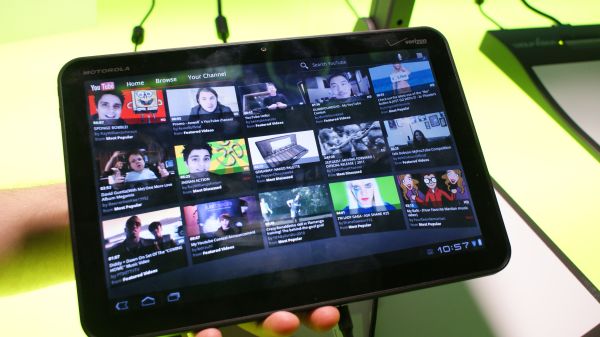Google Android 3.0 - Honeycomb Preview
by Saumitra Bhagwat on February 21, 2011 7:07 AM EST- Posted in
- Smartphones
- Honeycomb
- Android
- Mobile
Application Updates
Google has redesigned several of the core Android apps to take advantage of new UI elements like the Action Bar, hardware-accelerated graphics and of course the extra screen space. Apps like Music Player and YouTube have undergone some serious UI makeovers that really leverage the graphical prowess of the Renderscript graphics engine.

Just like on the iPad, Honeycomb brings a two pane UI to Email/Gmail. The app makes extensive use of the new Action Bar and “Fragments” framework to simplify workflows. Overall, the interface is clean and well organized.
Camera & Gallery

Froyo improved on the camera UI from Éclair (v2.1) by leaps and bounds; Honeycomb has taken it a step further and optimized it for two-handed operation on tablets. The new UI has a rotating dial-like interface that puts most important camera settings at your fingertips. The Gallery app has also been updated with a full-screen mode in addition to a thumbnail view of other pictures.
Browser
The browser on Honeycomb looks and feels a lot like Chrome. Its a serious upgrade to the stock Android browser found on earlier versions. Notable features include tabbed browsing, incognito mode, visual bookmarks, bookmark syncing and support for scalable vector graphics (SVG). SVG support was missing until now even though most mobile browsers like Opera Mini, Firefox Mobile and iOS Safari had supported it for a while. The Android browser has always shined performance-wise due to optimizations to JavaScript engine and the OS itself.
But a lot of the performance also depends on the underlying SoC. Google chose NVIDIA's Tegra 2 as the reference SoC for Honeycomb, so all of the initial Honecomb tablets will be based on NVIDIA's T20 SoC. For the latest benchmarks on Tegra 2 check out our Optimus 2X Review and Atrix 4G Preview.
Google Talk

The Google Talk app in Honeycomb (finally) adds support video conferencing. The interface is quite similar to the Gmail version of Google Talk. However, I’m more interested to see whether Honeycomb finally allows using multiple accounts with Google Talk. I was hoping Gingerbread would allow this, but alas I was proved wrong. The video conferencing interface is almost identical to how it’s handled in Gmail. Again, we’ll have more things to say as soon as we get our hands dirty with the Xoom.
Other Fixes

The keyboard has been slightly tweaked since Gingerbread and now includes a new “Tab” button. The keys have also been slightly modified for better placement and usability. The whole OS now supports multitouch gestures that are quite handy. Google has gone the extra mile to make sure that stock apps have a consistent and cohesive UI throughout. The OS now also adds a new UI for text selection, copy and paste that leverages the new Action Bar. Also included is an enhanced system-wide clipboard with drag and drop support that lets users copy, store and transfer content between parts of the OS and across applications. I’m sure there’ll be many minor tweaks and features scattered all over the OS, but we’ll have more on those in our detailed review soon enough.
Android Marketplace
The Marketplace app got a subtle facelift a few weeks ago, but was not updated with any new features in Gingerbread. The major announcement that came out of last week’s event was a web-based version of the Marketplace that you could browse from any computer. The website can also push purchased apps directly to your device within seconds. The other new feature is support for in-app purchases, which will be rolled out soon. Yet another example of the direction Google’s heading in with Android, tight integration with it’s own cloud services.
Developer Features
From a developer’s standpoint, Honeycomb features support for multiple cameras, multi-core processors, 2D/3D GPU acceleration across applications using the new Renderscript graphics engine, better compatibility across existing apps and so on. Also included is support for better multimedia and connectivity options like HTTP streaming, Media/Picture Transfer Protocol (MTP/PTP), a pluggable DRM framework to allow management of protected content regardless of the underlying DRM engine and API support for Bluetooth A2DP and HSP profiles. There are also some enhancements to the Enterprise feature set of the OS with policies for encrypted storage and password management.
Under The Hood Changes
Perhaps the biggest change in Honeycomb is that the Dalvik VM environment is now multi-core aware. This means the OS can now leverage the processing power and potential power savings of multi-core SoCs to speed things up and offer enhanced battery life. In fact, even single threaded apps can see speed improvements in Honeycomb. While running in a dual-core environment, the OS automatically lets the bytecode run on one core and the Dalvik garbage collector run on the other. Apps specifically written to support symmetric multiprocessing will see even larger performance gains. With companies like ARM (Cortex A15) and Qualcomm (Snapdragon “Krait”) already announcing their next-gen dual/quad-core SoC architectures, it will be exciting to see what kind of mobile performance we have in store for the future!











65 Comments
View All Comments
koss - Monday, February 21, 2011 - link
Interesting to see where google is going here. I don't know if it is just me or it really looks and borrows a lot from Windows. Fact is after so many releases there are things in windows (since probably 95) that just do not need to be changed or completely redesigned. They are optimized, yes, but nothing new really.I think this one will rock Apple's world and be a gamechanger in the tablet world. If only battery can go for > 24h somehow things are getting better in the tablet world.
BTW after Tegra2 will there be support for the other SOCs and when?
Cheers
Tros - Monday, February 21, 2011 - link
I doubt Google+* could beat Apple for battery life. Apple is fighting this problem on two fronts:Programming in iOS has a base design-philosophy of conserving power. There's no garbage collection in iOS, and almost all actions are event-driven. Plus, Apple is still researching in how to extend lithium-ion battery lifetime through different charging methods.
This is a strong contrast to Google, who is relying on other companies to fix the analog-portion, and the Android-platform, where performance is desired over efficiency (say, moving garbage collection to the second core).
I have to wonder who will win. The people trying to go for the laptop-holy-grail of interfacing with technology, or the people who disregard that.
InternetGeek - Monday, February 21, 2011 - link
So you are saying Apple has figured out an efficient way of using object-oriented design and development without using garbage collection. In other words, developers have to marshal their own resources. Must be a nightmare to program in objective-c.InternetGeek - Monday, February 21, 2011 - link
Just read objective-c does have a garbage collection based on reference counting.michael2k - Tuesday, February 22, 2011 - link
Yes, but how is marshalling resources a new thing?Even if it is a "nightmare", it's still profitable. No different than programming for any console, handheld, or computer up until the last 5 years.
InternetGeek - Wednesday, February 23, 2011 - link
I'm not sure what you mean and I'm not saying its bad by itself. PS3 programming is a nightmare because devs have to perform their own CPU scheduling. It seems Apple wants people to spend resources marshalling their own resources. Having to do that makes teams less productive. Thankfully Apple came to their senses and allowed binary compatibility.kmmatney - Monday, February 21, 2011 - link
I have an iPhone 3GS and my wife has an Android 2.2 (Froyo) based LG Optimus V. Both phones have the same basic specs with a 600 MHz cpu. I just bought here phone a few weeks ago, and mine is about 1.5 years old. I have to say I was surprised at how "choppy" her phone feels. The all-around UI is not nearly as smooth as my old iPhone, and even games like angry birds stutter a little bit. The battery life is also not nearly as good. Her phone is supposed to get an update to Gingerbread 2.3 in a few months, and I hope that makes things smoother.My initial impression is that Android needs better hardware to achieve the same smoothness as iOS. It also uses more battery power, even while not being nearly as smooth in the UI. I appreciate the freedom you get with Android, but I still think it needs more improvement.
koss - Monday, February 21, 2011 - link
True, Apple set the bar. But I think you are underestimating google a bit here. Look at their development curve and look at apple's(considering their tablet/phone upgrade strategy exceeds other products). Apple started where no one could come even close, now we are talking of some programming advantages. Mostly coming from the tighter structure of their platform.Multicore cpu+ efficient usage can compensate for sheer computing volume... no? Besides we are talking about at least 4 Socs and different optimizations from companies like samsung, nvidia and LG, not powercolor or club3d. I am not so confident apple can best the whole group.
Dex1701 - Monday, February 21, 2011 - link
Interesting. Is it possible that there is something wrong with your wife's device? My girlfriend has an iPhone 3GS and an iPhone 4. I will say that Apple does seem to go out of their way to make the general UI transition effects and such look nice. This is something I couldn't care less about, but it is aesthetically pleasing. The iPhone 4 is no exception.However, as far as overall performance my Galaxy S device with an EXT4 file system conversion feels much faster and has better battery life than a 3GS by far...even with a faster CPU and the same size battery. Granted, the CPU is faster than that of the Optimus V, but it's roughly the same as that of the iPhone 4, and side-by-side the Galaxy S "feels" just as fast. In fact, in games the Galaxy S is performing better than the iPhone 4 for the most part, although this can vary depending on how well optimized the software is for the particular set of hardware.
From what I've been seeing, Gingerbread has some rather large improvements in overall UI "smoothness" as well. I think I disagree with your assessment that Android requires better hardware to achieve the same results, though. My device "feels" just as snappy as my GF's iPhone 4, benchmarks just as well, and is running 5 screens worth of widgets in the background while iOS's core UI is just an app drawer and notifications. Is it possible that your wife's Optimus is bogged-down by a lot of bloatware?
Stas - Monday, February 21, 2011 - link
iOS has GPU accelerated UI. Android does everything on CPU. That's why the interface and transitions feel smoother on iPhone, yet when it comes to actual performance tests - it doesn't impress. Only some Android phones have dedicated GPUs, so while creating new UI engine, the developers would still have to keep and improve the old one for the less fortunate phones. Which kind of ticks me off. My Motorola Droid is capable of producing much smoother transitions that don't affect battery life so much, if given the proper software (because it has a very good GPU). Yet I see better transitions on cheap new phones with faster CPUs but worthless or non-existing GPUs, only due to how Andoid developers' prioritize feature implementation :(